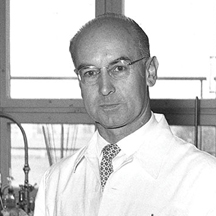Albert Hofmann (11 January 1906 – 29 April 2008) was a Swiss scientist known best for being the first person to synthesize, ingest, and learn of the psychedelic effects of lysergic acid diethylamide (LSD). Hofmann was also the first person to isolate, synthesize, and name the principal psychedelic mushroom compounds psilocybin and psilocin. He authored more than 100 scientific articles and numerous books, including LSD: Mein Sorgenkind (LSD: My Problem Child). In 2007, he shared first place, alongside Tim Berners-Lee, in a list of the 100 greatest living geniuses, published by The Telegraph newspaper. (More from Wikipedia)
The word “psychedelic” is composed of two ancient Greek words that mean “mind-revealing”. The word was coined in 1956 by Humphry Osmond, a psychiatrist who pioneered the promising use of hallucinogenic drugs like LSD in psychotherapy. This quintessential hallucinogen was first synthesized in 1938 by Albert Hofmann from a compound found in the ergot fungus that commonly grows on rye florets and causes a condition called ergotism (also known as St. Anthony’s Fire) in humans and other mammals. The widespread recreational use of LSD and other similar drugs in the 1960’s counterculture put the kibosh on any therapeutic uses for decades, although there have been some halting steps recently toward its revival in psychotherapy, since mental illness is every bit as intractable today as it was 60 years ago.
(July 2015)















